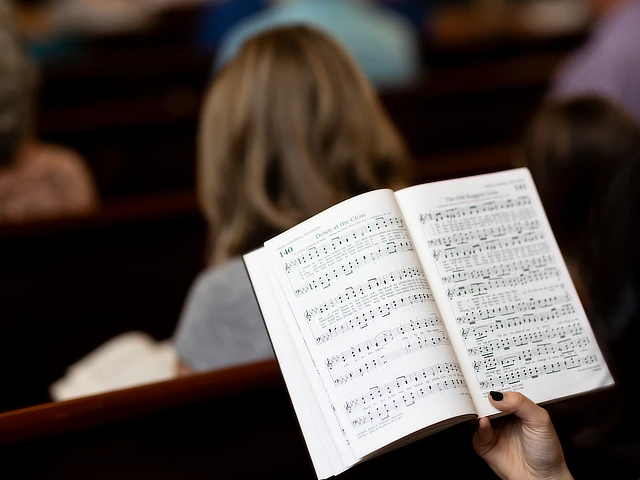
One of the questions I frequently hear from worship leaders and pastors is, “How do I get my congregation to engage during worship?” It’s a problem we see in a lot of churches today; people are just not singing. They may be standing and politely listening, but they’re not participating. The first couple rows might really be into it; that’s where all the “worship groupies” sit. But look beyond the first few rows. Sit in the back sometime and you’ll see exactly what I’m talking about. A large number of people, and in many cases the majority of them, are not participating. Some are just staring passively into space. I know you can’t always judge by appearances, but it’s pretty obvious that the majority of church goers today aren’t fully engaged during worship.
Reasons vary for this problem and it’s worth a lengthy discussion. But one of the first things I suggest we consider is whether there’s anything we as worship leaders are doing that is inhibiting participation. Sometimes there are things we do (unintentionally of course) that work against us. With that in mind, I have five practical suggestions for those of us who plan and lead worship services.
- Make sure the music is singable. Congregation members tend to drop out if a song is too complicated rhythmically or melodically or if the key is too high. That may sound obvious, but I continue to see numerous examples where this cardinal rule is blatantly ignored. Sometimes we worship leaders put songs in keys that are good for us, but they’re not good for the congregation. I can always tell when a song is too high, because I hear the volume of the congregation all of a sudden get softer; people drop out, especially men. Be sure to select songs that your congregation can sing and put them in keys they can handle.
- Feature familiar songs. The people in the pews tend to sing out on songs they know, so make sure the majority of the tunes in any given worship set are familiar. As a rule of thumb, most congregations can’t handle more than one new song each week. By “new” song, I mean one used three times or less. After three outings, the song should be familiar. I would also avoid starting a worship set with a new or unfamiliar song. That tends to get the service off to a weak start from which it is difficult to recover. Also, keep in mind that we worship leaders tend to tire more quickly of songs than the congregation does simply because we’ve been playing them far more often in rehearsal and services. Don’t automatically assume that just because you’re tired of a song the congregation is also tired of it.
- Encourage your vocalists to sing always. If the congregation sees a group of singers upfront, but only one of them is singing, it sends mixed signals as people starting wondering: Are we all supposed to sing or is this a solo? The current trend toward shared leads brings much needed variety, but be careful that it doesn’t come off feeling like a concert. Just because one singer is leading out on a verse doesn’t mean all other singers stop worshiping. Instead of completely dropping out, the support vocalists should simply step away from the mic but continue to sing and stay engaged as worshipers. Remember, congregations are notoriously shy. They’re not sitting on the edge of their seats chomping at the bit to sing. If they have any doubts as to whether they’re supposed to sing, they won’t. Unless a song is designed to be “presentational,” make sure your singers lead by example and stay engaged throughout.
- Encourage your instrumentalists to worship while they play. It may not be reasonable to expect instrumentalists to sing every note as they play, but if they can join in on the chorus or the bridge whenever possible it sends a clear message that their playing is not meant to be a performance, that they’re worshiping. Singing as they play, even if their vocals aren’t on mic, is part of their role as band members on the worship team.
- Teach about worship. The most effective way to inspire enthusiasm for worship is to teach about it. On occasion, I’ll ask worship leaders, “When was the last time your pastor preached a sermon about worship?” Sadly, the reply I most commonly hear is, “Never.” Teaching about biblical worship from the pulpit goes a long way in creating and sustaining a culture of participation. There are also numerous books about worship available for small group study. Even brief, well-crafted comments you make between songs as you lead can increase the congregation’s understanding and appreciation of worship.
We invite you to join us on Thursday, November 7 at 10:00 a.m. for a time of worship at Samford in Reid Chapel, led by Samford Worship Collective with a word from Rory Noland, followed by a FREE lunch at 11:30 a.m. (must register for the lunch) with the CWA staff and Rory Noland in the Rotunda Club as we discuss the Heart of the Artist – Spiritual Wellness for Ministry Leaders

Rory Noland is the director of Heart of the Artist Ministries, an organization dedicated to serving artists in the church. Serving in church leadership for over 40 years, Rory continues to mentor worship leaders, speak at churches, colleges, and conferences, lead retreats for artists, and consult with churches in the areas of worship, spiritual formation, and the arts. Rory is also a published songwriter and has authored six books, including the best-selling book, The Heart of the Artist: A Character-Building Guide For You and Your Ministry Team.
